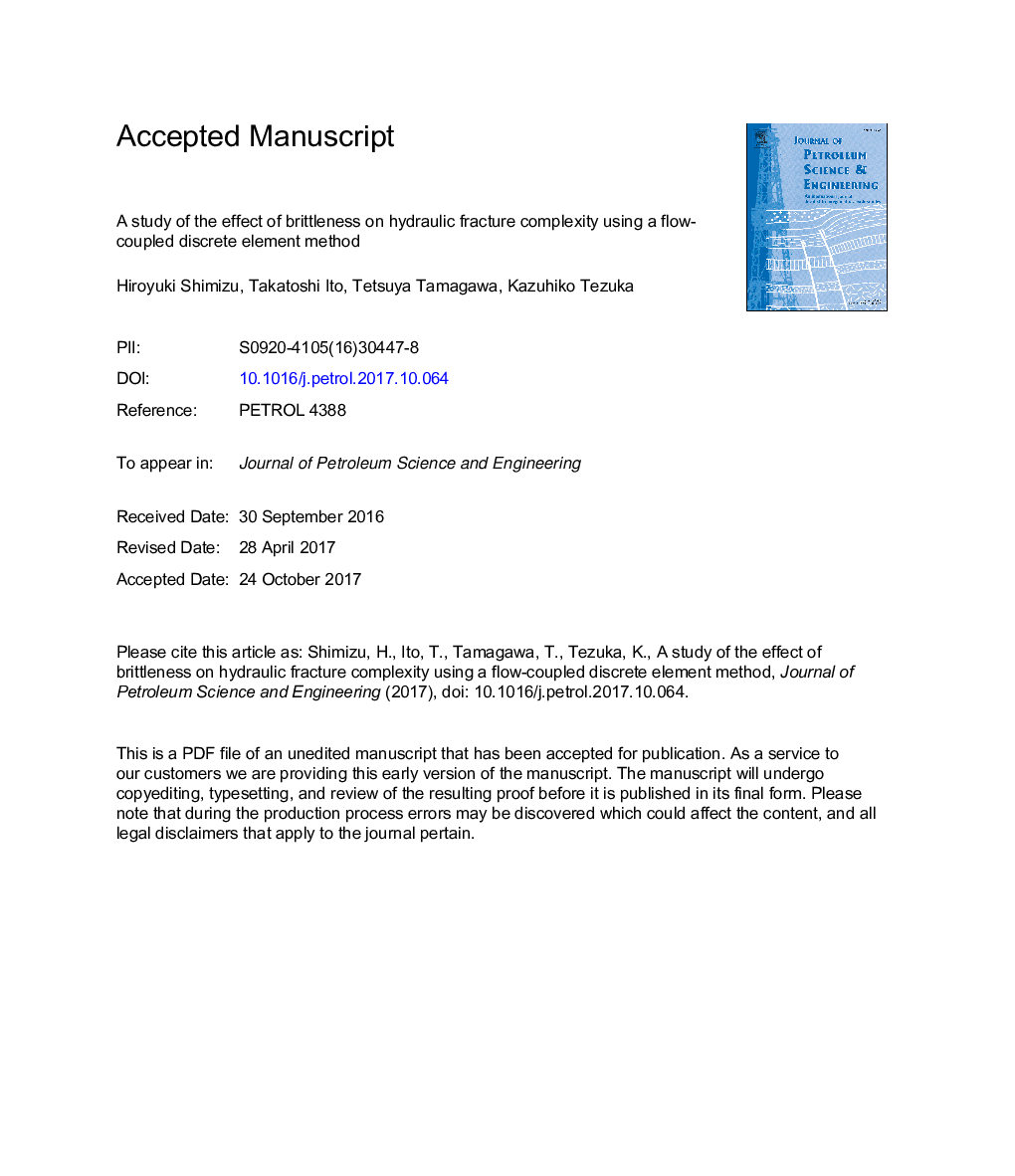| کد مقاله | کد نشریه | سال انتشار | مقاله انگلیسی | نسخه تمام متن |
|---|---|---|---|---|
| 8125548 | 1522781 | 2018 | 40 صفحه PDF | دانلود رایگان |
عنوان انگلیسی مقاله ISI
A study of the effect of brittleness on hydraulic fracture complexity using a flow-coupled discrete element method
ترجمه فارسی عنوان
مطالعه اثر شکنندگی بر روی پیچیدگی شکست هیدرولیکی با استفاده از روش عنصر دیجیتالی متصل به جریان
دانلود مقاله + سفارش ترجمه
دانلود مقاله ISI انگلیسی
رایگان برای ایرانیان
کلمات کلیدی
مخزن تنگ شکستگی هیدرولیکی، شکنجه، روش عنصر گسسته، شکستگی پیش از آن،
ترجمه چکیده
در سال های اخیر، شکستگی هیدرولیکی به عنوان یک تکنیک مهم برای توسعه مخازن گاز و مخازن نفت غیر متعارف، به ویژه مخازن شیل تبدیل شده است. تولید از مخزن تنگ نیاز به ایجاد هیدرولیکی از یک شبکه بسیار شکست خورده برای به طور قابل توجهی بهبود هدایت هیدرولیکی مخزن. مشاهدات فصلی تجربی نشان می دهد که پیچیدگی شکستی در مورد سنگ شکن سنگین بالاتر است که به عنوان ترکیبی از مدول یانگ و نسبت پواسون سنگ شناخته می شود. شکنندگی به عنوان یکی از مهمترین خواص مکانیکی سنگ مخازن تنگ غیر متعارف در نظر گرفته شده است. با این حال، رابطه فیزیکی بین پیچیدگی شکست و شکستگی هنوز معلوم نیست. در این مطالعه، یک سری از شبیه سازی های شکست هیدرولیکی با استفاده از روش عنصر گسسته جوی با استفاده از جریان به دست آمده برای به دست آوردن بینش در مورد اثر شکنندگی بر روی شکست شکست انجام شد. رطوبتی با ترکیب های مختلف مدول یانگ و نسبت پواسون برای چهار مدل سنگ تنظیم شد. با توجه به خواص مکانیکی سنگ و شکستگی های قبل از آن، استرس موثر در مورد ضخامت پایه به تنش تنها در اطراف نوک شکستگی های هیدرولیک و قبل از آن منجر شد. برعکس، منطقه کششی در طول شکست قبل از وقوع بیشتر در مورد شکستگی بالاتر توزیع شد. استرس کششی موثر در یک منطقه وسیع تر باید میکروارگانیسم های بیشتری را ایجاد کند، بنابراین احتمال سقوط هیدرولیکی از شکسته شدن قبل از آن افزایش می یابد. این ملاحظات نشان دهنده یک همبستگی مثبت بین شکنندگی و پیچیدگی سیستم شکستگی ناشی از هیدرولیکی است.
موضوعات مرتبط
مهندسی و علوم پایه
علوم زمین و سیارات
زمین شناسی اقتصادی
چکیده انگلیسی
In recent years, hydraulic fracturing has emerged as an important technique for the development of unconventional tight gas and oil reservoirs, particularly shale reservoirs. Production from a tight reservoir requires hydraulic creation of a highly fractured network for significantly improving the hydraulic conductivity of the reservoir. Field observations have empirically indicated that fracture complexity tends to be higher in the case of higher rock brittleness which is defined as the combination of the Young's modulus and Poisson's ratio of a rock. The brittleness is considered as one of the most important mechanical rock properties of unconventional tight reservoirs. However, the physical relationship between fracture complexity and the brittleness remains unclear. In this study, a series of hydraulic fracturing simulations were performed using a flow-coupled discrete element method to gain insights into the effect of the brittleness on fracture propagation. The brittleness was adjusted under different combinations of Young's modulus and Poisson's ratio for four rock models. Considering mechanical rock properties and pre-existing fractures, the effective stress in the case of lower brittleness reduced to the tension only around the tip of the hydraulic and pre-existing fractures. On the contrary, the tensile region was more widely distributed along the pre-existing fracture in the case of higher brittleness. The effective tensile stress in a wider region should induce more microcracks, thereby enhancing the possibility of the hydraulic fracture branching off from the pre-existing fracture. These considerations indicate a positive correlation between the brittleness and the complexity of a hydraulically induced fracture system.
ناشر
Database: Elsevier - ScienceDirect (ساینس دایرکت)
Journal: Journal of Petroleum Science and Engineering - Volume 160, January 2018, Pages 372-383
Journal: Journal of Petroleum Science and Engineering - Volume 160, January 2018, Pages 372-383
نویسندگان
Hiroyuki Shimizu, Takatoshi Ito, Tetsuya Tamagawa, Kazuhiko Tezuka,
